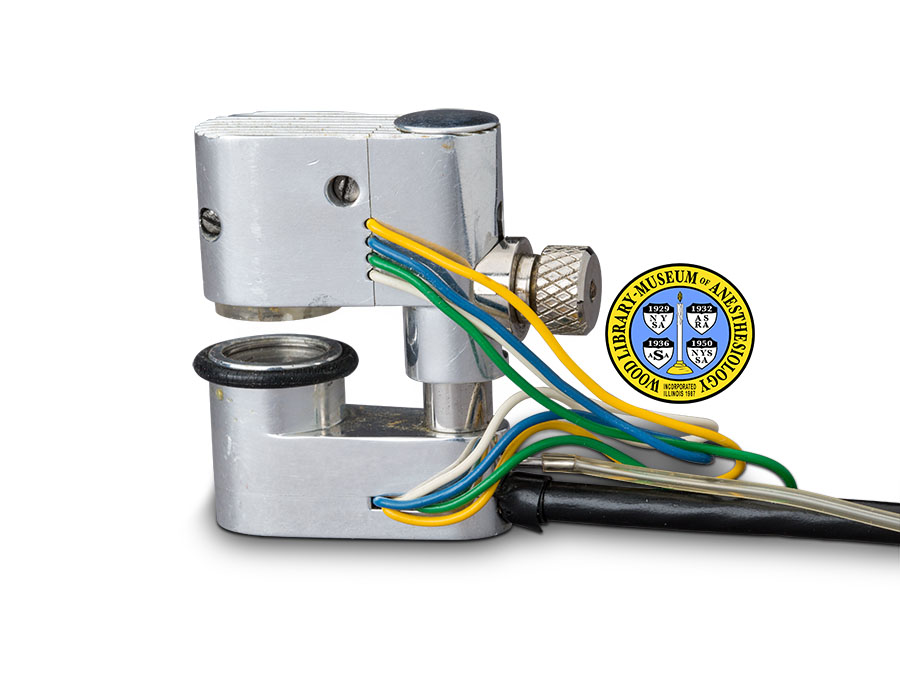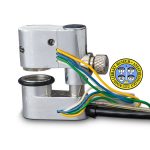Waters XE-60A Ear Oximeter
Anesthesiologists monitor and manage the surgical patient’s breathing and other vital functions. Beginning in the 1940s, the increasing use of mechanical ventilators in anesthesia led to a demand for better oxygen monitors. An oximeter continuously monitors the amount of oxygen in a person’s blood. By sending two or more wavelengths of light through the thinnest parts of the body, such as the ear, and then reading the extent to which that light is absorbed by the blood and tissues, transmission oximeters provided an accurate, noninvasive measurement of blood oxygenation.
The first ear oximeter was introduced in 1942 by American physiologist, Glenn A. Millikan (1906-1947), for use in military aviation. In 1949, it was modified by Earl H. Wood, M.D. (1912-2009) and his colleagues at the Mayo Clinic, in Rochester, MN, who were also working on problems of military aviation. Dr. Wood’s oximeter was made by Waters Conley Co. of Minneapolis, MN. The successor to that firm, Waters Company of Rochester, MN, went on to make commercial oximeters and other medical equipment.
The earpiece shown here is just one component of a Waters XE-60A ear oximeter, advertised in the 1960s. It strongly resembles that made for Dr. Wood. Also shown is an example of the photoelectric cell that was part of the apparatus. An improved technology, pulse oximetry, became widely available in the 1980s.
Catalog Record: Waters XE-60A Ear Oximeter Waters XE-60A Ear Oximeter
Access Key: amyh
Accession No.: 2012-05-30-1 B
Title: Model XE-60A / Waters Corporation.
Corporate Author: Waters Corporation.
Title variation: Alt Title
Title: Waters XE-60A oximeter earpiece.
Publisher: Rochester, Minnesota : Waters Corporation, [between 1954 and 1983].
Physical Description: 1 oximeter earpiece : metals, plastics ; 4 x 2.5 x 183 cm.
Subject: Blood Gas Monitoring, Transcutaneous – instrumentation.
Subject: Oxygen – analysis.
Subject: Oximetry – instrumentation.
Web Link: https://www.woodlibrarymuseum.org/museum/item/1031/waters-xe-60a-ear-oximeter
Note Type: General
Notes: The first year in the date range is the year that Mr. George Waters left Waters Conley Co. and founded The Waters Company. The second year in the date range is the year that the Nellcor 100 pulse oximeter was introduced. The name marked on this item, “Waters Corporation”, has not been found by the cataloger in any publication, but it is understood to be one of several names under which The Waters Company did business.
Note Type: General
Notes: Dr. Wood’s 1949 earpiece appears in two photographs on page 5 of the 1986 textbook by Payne and Severinghaus. In the photo on the left, the metal head which attaches to the subject’s ear is standing upright on its only flat surface; in this orientation, the earpiece resembles a microscope. In the photo on the right the earpiece is shown in use, with the arch placed over the top of the subject’s ear, the flat slab resting on the back of the ear, the front of the barrel inside the ear, and the depth of the barrel, and the tubes, extending outward. That is the orientation in which this item is described, with the arch on top and the screw on the bottom. The marked side of the flat slab is considered the front and the distal end of the barrel is considered the back.
Note Type: Citation
Notes: American Society of Anesthesiologists. Standards for Basic Intra-Operative Monitoring. Park Ridge, Illinois: American Society of Anesthesiologists, 1989. Standards, Guidelines and Statements Series. American Society of Anesthesiologists Archives. Located at: Wood Library-Museum of Anesthesiology, Schaumburg, Illinois.
Note Type: Citation
Notes: Earl H. (Howard) Wood. Minnesota Science and Technology Hall of Fame website. http://www.msthalloffame.org/earl_wood.htm. Accessed June 21, 2016.
Note Type: Citation
Notes: All Nobel Prizes in Physics. Nobel Foundation website. http://www.nobelprize.org/nobel_prizes/physics/laureates/. Accessed June 21, 2016.
Note Type: Citation
Notes: Payne JP, Severinghaus JW, eds. Pulse Oximetry. London: Springer-Verlag, 1986.
Note Type: Citation
Notes: A Historical Perspective. RT Magazine website. http://www.rtmagazine.com/2007/02/a-historical-perspective/. Accessed June 20, 2016.
Note Type: Citation
Notes: Severinghaus JW, Astrup PB. History of Blood Gas Analysis. Boston: Little, Brown, 1987. International Anesthesiology Clinics. Winter, 1987;24(4):167-204.
Note Type: Citation
Notes: George Franklin Waters [Obituary]. Star Tribune Media Company website. http://www.startribune.com/obituaries/detail/85646/?fullname=george-franklin-waters. Accessed June 16, 2016.
Note Type: Citation
Notes: Waters Company [company file]. Archives. Located at: Wood Library-Museum of Anesthesiology, Schaumburg, Illinois.
Note Type: Physical Description
Notes: One oximeter earpiece; The metal head measures 4.5 x 2.5 x 5.5 centimeters; The head consists of a cylindrical barrel with one metal attachment above and one below; The upper attachment is that portion which hangs over the rim of the subject’s ear; It is attached to the top of the barrel with two screws; It consists of an arch that juts forward of the barrel, and terminates in a flat, hollow slab that hangs downward from the arch; The slab is approximately .5 centimeter thick; The front of the slab is marked “EAR OXIMETER [new line] MODEL XE-60A NO. 280 [new line] PAT. APPLIED FOR [new line] THE WATERS CORPORATION [new line] Rochester, Minnesota”; The back of the slab (facing the barrel) holds a disc made of either glass or plastic; The disc covers an opening to the interior of the hollow slab;
An oblong groove in the underside of the barrel holds a small metal fixture, approximately 1 centimeter square, that is affixed to the barrel by a screw; This fixture looks as though it would slide back and forth along the groove, but it is stationary;
A black plastic tube, approximately 70 centimeters long, emerges from the back of the barrel; A needle is attached to this tube by a metal clamp; The needle is marked “B-D [new line] 20”; The opposite end of this tube enters a metal electrical fitting that measures 2.5 centimeters in diameter and 5 centimeters in depth; The hub of this fitting is marked “WK–6–21C–5/16 [new line] CANNON”; The open end of this fitting has a rosette of six holes, marked clockwise from “1” to “5”, with “6” in the center;
A clear plastic tube, approximately 41 centimeters long, emerges from the front of the barrel; At its opposite end, this clear tube is attached to the needle that is clamped to the long black tube; A short black tube emerges from the arched portion of the head; This tube is joined to the longer black tube by adhesive tape; One end of a short metal wire is looped through a hole in the metal arch; The opposite end of this wire also is attached to the long black tube with adhesive tape.
Note Type: Reproduction
Notes: Photographed by Mr. Steve Donisch, January 13, 2016.
Note Type: Acquisition
Notes: Gift of Diane Bohlman, M.D.
Note Type: Historical
Notes: Anesthesiologists monitor and manage the surgical patient’s breathing and other vital functions. The introduction of muscle relaxant drugs in the 1940s, and the polio epidemics of the 1950s, led to the increasing use of mechanical ventilators in anesthesia. These developments, together with improvements in heart surgery and the needs of high-altitude aviation, created a demand for better oxygen monitors.
The role of hemoglobin as the carrier of oxygen in the blood was first understood in the 1860s. In 1874, German physician Karl von Vierordt (1818-1884) studied the oxygenation of his own blood by using a spectroscope to measure light that was passed through his hand. In the 1930s, the use of photoelectric cells allowed more accurate measurement of blood gases, and the first oximeters were created. An oximeter continuously monitors the amount of oxygen in a person’s blood. By sending two or more wavelengths of light through the thinnest parts of the body, such as the ear, and then reading the extent to which that light is absorbed by the blood and tissues, the devices called transmission oximeters provide an accurate, noninvasive measurement of the oxygen saturation of hemoglobin in arterial blood.
The first ear oximeter was introduced in 1942 by American physiologist, Glenn A. Milliken (1906-1947), who also coined the word “oximetry”. Developed for military aviation, the device used mercury vapor light, colored filters and a photoelectric cell. Milliken’s oximeter was modified in 1949 by Earl H. Wood, M.D. (1912-2009) and his colleagues at the Mayo Clinic, in Rochester, MN. This team, also, were working on problems of military aviation. Dr. Wood’s oximeter was made by Waters Conley Co. of Minneapolis, MN. The successor to that firm, The Waters Company of Rochester, MN, went on to make commercial oximeters and other medical equipment. The earpiece described in this record is just one component of a Waters XE-60A ear oximeter, which was advertised in the 1960s. The earpiece strongly resembles that made for Dr. Wood. Some parts may be missing from this example of the earpiece.
An improved technology, pulse oximetry, became widely available in the 1980s. In 1989, the American Society of Anesthesiologists adopted new Standards for Basic Intra-Operative Monitoring, requiring assessment of the patient’s blood oxygenation during all anesthetics.
Note Type: Publication
Notes: Millikin, GA. The oximeter, an instrument for measuring continuously the oxygen saturation of arterial blood in man. Rev Sci Instrum. 1942;13:434.
Note Type: Publication
Notes: Wood, EH. A single scale absolute reading ear oximeter. Proc Staff Meet Mayo Clin. July 5, 1950; 25(14):384-391.
Note Type: Exhibition
Notes: Selected for the WLM website.


